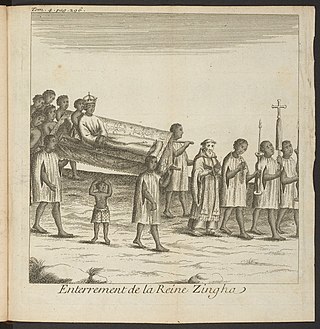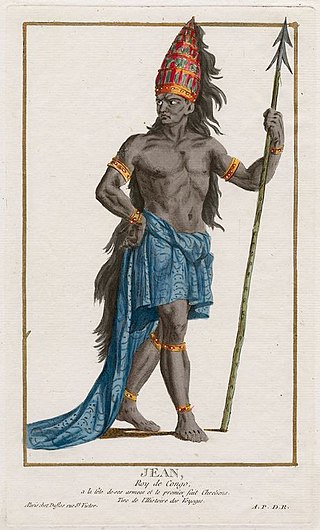Related Research Articles

Nzinga Ana de Sousa Mbande was a southwest African ruler who ruled as queen of the Ambundu Kingdoms of Ndongo (1624–1663) and Matamba (1631–1663), located in present-day northern Angola. Born into the ruling family of Ndongo, her father Ngola Kilombo Kia Kasenda was the king of Ndongo.
The Kingdom of Ndongo, 1515-1909, was an early-modern African state located in the highlands between the Lukala and Kwanza Rivers, in what is now Angola.
The Imbangala or Mbangala were divided groups of warriors and marauders who worked as hired mercenaries in 17th-century Angola and later founded the Kasanje Kingdom.
The Kingdom of Matamba (1631–1744) was an African state located in what is now the Baixa de Cassange region of Malanje Province of modern-day Angola. Joined to the Kingdom of Ndongo by Queen Nzinga in 1631, the state had many male and female rulers. It was a powerful kingdom that long resisted Portuguese colonisation attempts, but was integrated into Portuguese Angola in the late nineteenth century.
Verónica Guterres Kangala Kingwanda was the ruler of the joint kingdom of Ndongo and Matamba, 1681–1721.

The Ambundu or Mbundu (Mbundu: Ambundu or Akwambundu, singular: Mumbundu are a Bantu people who live on a high plateau in present-day Angola just north of the Kwanza River. The Ambundu speak Kimbundu, and most also speak the official language of the country, Portuguese. They are the second biggest ethnic group in the country and make up 25% of the total population of Angola.

Giovanni Antonio Cavazzi da Montecuccolo (1621–1678) was an Italian Capuchin missionary noted for his travels in 17th century Portuguese Angola and his lengthy account of local history and culture as well as a history of the Capuchin mission there.

Nzinga-a-Nkuwu João I was the 5th ManiKongo of the Kingdom of Kongo between 1470 and 1509. He voluntarily converted to Roman Catholicism. He was baptized on 3 May 1491 and took the Christian name of João. Soon after, ManiKongo Nzinga-a-Nkuwu João I abandoned the new faith for a number of reasons, one of them being the Roman Catholic Church's requirement of monogamy. Politically, he could not afford to abandon polygamy and embrace monogamy, a cultural shift that the king could not contemplate as power in Kongo was elective, rather than hereditary as in Europe; as Kongo culture followed a matrilineality structure, where the elder son of the king is not automatically the next king.
The Battle of Kombi was a decisive battle in the war between Ndongo-Matamba and Portugal during the Dutch period of Angolan history.
The precolonial history of Angola lasted until Portugal annexed the territory as a colony in 1655.
The Kasanje Kingdom (1620–1910), also known as the Jaga Kingdom, was a Central African state. It was formed in 1620 by a mercenary band of Imbangala, which had deserted the Portuguese ranks. The state gets its name from the leader of the band, Kasanje, who settled his followers on the upper Kwango River. The Kasanje people were ruled by the Jaga, a king who was elected from among the three clans who founded the kingdom.
The Battle of Katole was a military engagement between forces of Portuguese Angola and the Kingdom of Matamba. The battle took place on 4 September 1681 at Katole in what is today Angola. It was one of the largest military engagements anywhere in the world during the 17th century.
The Portuguese colony of Angola was founded in 1575 with the arrival of Paulo Dias de Novais with a hundred families of colonists and four hundred soldiers. Luanda was granted the status of city in 1605. The fortified Portuguese towns of Luanda and Benguela.
Ana II Guterres da Silva Ngola Kanini was the queen regnant of the Kingdom of Ndongo and Matamba from 1742 to 1756.
Verónica II Guterres was the queen regnant of the Kingdom of Ndongo and Matamba from 1756 to 1758.
Ana III Guterres was the queen regnant of the Kingdom of Ndongo and Matamba from 1758 to 1767.
Kamana, Queen of Jinga was the queen regnant of the Kingdom of Jinga from 1767 to 1810.

The Battle of Pungo Andongo, also known as the siege of Pungo Andongo was a military engagement in what is today Angola between Portugal and the Kingdom of Ndongo whose capital, Pungo Andongo, also known as Pedras Negras, was besieged. After a nine-month encirclement, the capital was taken by storm, plundered and occupied by the Portuguese.
References
- Anthony Appiah, Henry Louis Gates, Encyclopedia of Africa, Volym 1
- From Eve to Dawn: A History of Women in the World Volume II
- Njinga of Angola
- Fernando Campos: Conflitos na dinastia Guterres através da sua cronologia1, África: Revista do Centro de Estudos Africanos. USP, S. Paulo, 27-28: 23-43, 2006/2007